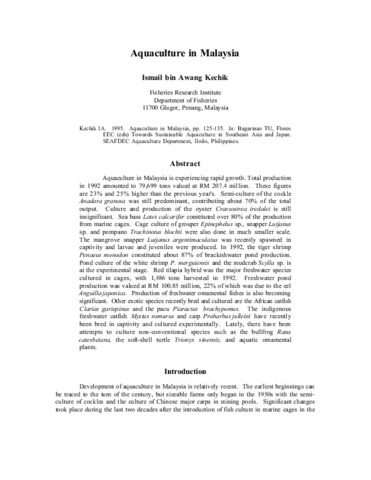Perlihatkan publikasi sederhana
A guide to small-scale marine finfish hatchery technology
| dc.contributor.author | Sim, Sih-Yang | |
| dc.contributor.author | Rimmer, Michael A. | |
| dc.contributor.author | Toledo, Joebert D. | |
| dc.contributor.author | Sugama, Ketut | |
| dc.contributor.author | Rumengan, Inneke | |
| dc.contributor.author | Williams, Kevin | |
| dc.contributor.author | Phillips, Michael J. | |
| dc.date.accessioned | 2018-06-27T01:48:58Z | |
| dc.date.available | 2018-06-27T01:48:58Z | |
| dc.date.issued | 2005 | |
| dc.identifier.citation | Sim, S. Y., Rimmer, M. A., Toledo, J. D., Sugama, S., Rumengan, I., Williams, K. C., & Phillips, M. J. (2005). A guide to small-scale marine finfish hatchery technology. Bangkok, Thailand: Network of Aquaculture Centres in Asia-Pacific. 17pp. | en |
| dc.identifier.isbn | 9749305329 | |
| dc.identifier.uri | http://hdl.handle.net/10862/3321 | |
| dc.description.abstract | Recent improvements in hatchery production technology for high-value marine finfish species such as groupers have led to an increased interest in setting up hatcheries to produce fingerlings for aquaculture. Small-scale hatcheries make this technology available to poor people in developing countries. Capital costs for small-scale hatcheries are relatively low, and the profitability of these ventures ensures rapid payback of capital investment. This guide provides an outline of the requirements to establish a small-scale marine finfish hatchery, particularly the economic aspects. It is intended to provide sufficient information for potential investors to decide whether investment in such ventures is appropriate for them. The guide provides some basic technical information in order to give an indication of the level of technical expertise necessary to operate a small-scale marine finfish hatchery. However, it is not intended as a detailed technical guide to the operation of small-scale hatcheries. Additional resources, such as training courses in marine finfish hatchery production, are available and these are listed in this document. Development of small-scale hatcheries may be more appropriate where there are existing marine hatchery operations, e.g. for shrimp or milkfish. By definition, small-scale hatcheries do not have broodstock facilities, so a supply of fertilised eggs (usually from a larger hatchery) is essential. Access to fertilised eggs and experienced hatchery staff will limit the application of small-scale hatchery technology. Despite this, there is considerable potential for this technology to be widely adopted. This guide has been written by a team of experts in marine finfish aquaculture who have been involved in a multinational collaborative research project since 1999. | en |
| dc.format.extent | vi, 17 p. : col. ill. | en |
| dc.language.iso | en | en |
| dc.publisher | Network of Aquaculture Centres in Asia-Pacific | en |
| dc.relation.ispartofseries | Asia-Pacific Marine Finfish Aquaculture Network; Publication No. 2005–01 | |
| dc.relation.uri | http://library.enaca.org/Grouper/Publications/grouper-hatchery-guide.pdf | en |
| dc.subject | milkfish | en |
| dc.subject | groupers | en |
| dc.subject | Rotifera | en |
| dc.title | A guide to small-scale marine finfish hatchery technology | en |
| dc.type | Book | en |
| dc.subject.asfa | fish culture | en |
| dc.subject.asfa | milkfish culture | en |
| dc.subject.asfa | cultured organisms | en |
| dc.subject.asfa | grouper culture | en |
| dc.subject.asfa | algal culture | en |
| dc.subject.asfa | brine shrimp culture | en |
| dc.subject.asfa | shrimp culture | en |
| dc.subject.asfa | hatcheries | en |
Files in this item
| Files | Size | Format | View |
|---|---|---|---|
|
There are no files associated with this item. |
|||
Publikasi ini ada di koleksi berikut
-
Books and Book Chapters [123]



